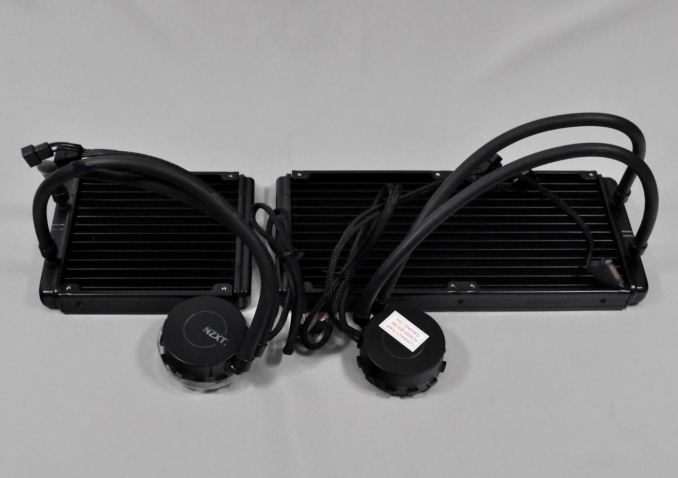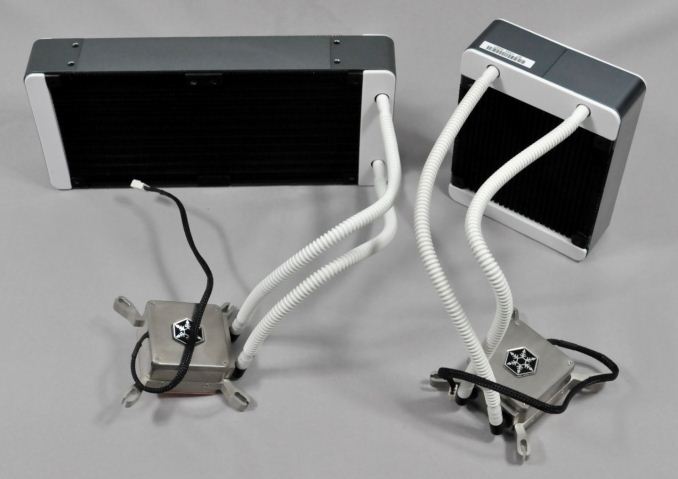Closed Loop AIO Liquid Coolers: 14-way Mega Roundup Review
by E. Fylladitakis on February 12, 2014 7:00 AM ESTEnermax
The two AIO coolers from Enermax that we had the chance to look at share a similarly sized, 120mm x 120mm radiator, yet they are absolutely nothing alike. The Liqmax 120S is a product designed with value in mind, to compete with AIO coolers in the league of the Cooler Master Seidon 120V and the Corsair H75. Its thermal performance is unimpressive, slightly worse than that of the Seidon 120V, yet the noise levels of the Liqmax 120S are considerably lower. It is unable to compete with the dual-fan H75 though, at least not while maintaining similar noise levels.
The Liqtech 120X on the other hand is very impressive, especially in terms of quality and aesthetics. A simple inspection reveals that the radiator and block of the Liqtech 120X are much better made than those of most other kits. It delivers good thermal performance while maintaining very low noise levels, considering the size of its radiator and the use of 120mm fans. The downside is that the Liqtech 120X owes much of its good performance on the extra-thick radiator, which could lead to compatibility problems with some cases if there is not enough clearance.
The only great problem that all AIO coolers from Enermax have is the low availability, as they currently are not available in North America at all and few retailers stock them in Europe. They can be imported to the US from Asia or Europe but that is a financially unrealistic option.
NZXT
NZXT currently offers only two high performance AIO coolers, both with 140mm wide radiators, which limits their compatibility significantly. On the other hand, they are the only coolers with extended (≈ 40cm) tubing, allowing the radiator to reach the front panel of a tower case. Still, the number of cases currently capable of supporting a 140mm wide radiator is quite limited.
Both the Kraken X40 and the Kraken X60 performed well in our tests, offering thermal performance similar to other AIO coolers of the same class. Specifically, they offer lower thermal performance than Cooler Master's 140mm wide coolers but maintain reasonable noise levels, while they display about the same thermal performance as Corsair's offerings but are not as quiet. While better fans could have been selected, NZXT has a tremendous advantage over the competition; the Kraken X40 and Kraken X60 retail for about the same price as other 140mm wide AIO coolers but only NZXT's offerings feature a USB interface. The USB interface allows the user to monitor and fine-tune the performance/noise ratio of the cooling system directly from the desktop, as well as to program custom LED lighting colors and effects.
Silverstone
Silverstone currently offers only two AIO liquid coolers, the Tundra TD02 and the Tundra TD03, both of which we have tested in this review. They are both based on the same design, with their only difference being the size of the radiator. Although the design of the Tundra TD03 is similar to that of the Enermax Liqtech 120X, the aesthetic design of Silverstone's offerings is quite different, going with a white/grey/nickel color theme instead of Enermax's black/red. The OEM behind them might be the same, although that is a mere guess on our part, as the fin design and frame of the radiators are significantly different.
The appearance, feel and quality of the Tundra TD02 and Tundra 03 are outstanding, greatly superior to that of most other kits. On the other hand, the overall performance of these kits actually disappointed us. It is by no means bad, as both of Silverstone's AIO coolers deliver thermal performance comparable to that of other similarly sized kits at reasonable noise levels and are especially efficient under low fan speeds. However, we expected a lot more from kits with radiators this thick and with such a classy appearance.
The mediocre performance may be due to the narrow corrugated tubing, a weak pump, a wrong choice of fans, or any combination of the above, but the fact is that a performance upgrade is required in order to overtake the competition. Furthermore, we are unsure about the white/grey color theme, as it will most likely stand out way too much inside all-black cases and that is not always the desired effect. Still, the balance between quality, performance, and value is very good and Silverstone's AIO coolers will become a favorite among those who want to combine low-noise operation and good looks. Just make sure that the 45mm thick radiators will fit inside your system before purchasing one!













139 Comments
View All Comments
jmke - Wednesday, February 12, 2014 - link
as with everything, the noise scale and extreme focus of SPCR does give a slightly twisted view.none of these AIO would qualify as silent, anything above 30dBA would be loud for him; his kitchen is <30dBA... ;-)
EnzoFX - Wednesday, February 12, 2014 - link
>30DB is loud lol. At least audible to anyone I would say, so can't we at least say it's not silent? Furthermore he'd provide at least a vast array of reference points, where Anandtech is severely lacking when it comes to cooling/cases/etc.E.Fyll - Wednesday, February 12, 2014 - link
Definitely not loud and not even audible to most. 30 dB(A) is the lowermost threshold that the vast majority of sound level meters can take a reading from. I have provided a thorough explanation about this down below in the comments. I personally consider any test that I have seen stating that they got a valid reading below 30 dB(A) with sub - $30k equipment to be rubbish.Jon-R - Wednesday, February 12, 2014 - link
So you're saying that the tests over at SilentPCReview are rubbish? What sound measurement equipment did you use? I couldn't find a mention of it.JlHADJOE - Thursday, February 13, 2014 - link
30 dB is very quiet far as background noise goes.Whisper Quiet Library at 6' 30dB
Sauce: http://www.gcaudio.com/resources/howtos/loudness.h...
JlHADJOE - Friday, February 14, 2014 - link
It's not so much that their tests are rubbish, just unrealistic.SilentPC tests in an anechoic chamber, so the noise floor when they test is near zero. Compared to that, an increase to 30dBA is very loud. But in a real-world environment, 30dBA is whisper quiet.
I do agree though that use of the anechoic chamber keeps their tests consistent and repeatable. Just not necessarily representative of what a case will actually sound like in a real room.
YazX_ - Wednesday, February 12, 2014 - link
Thx for this thorough review, i have corsair H100i, its awesome AIO cooler, but the fans are piece of shit and very noisy, i replaced them with Bitfenix LED ones, although they operate at 1800 RPM, but i never had to see them operate on that speed, my CPU is OCed to 4.5Ghz and max temp is 65, so they work 50% most of the time and pretty silent.AshyPistachios - Wednesday, February 12, 2014 - link
This ended up comparing fans more than it did rads/pumps. I would like to see a test scenario where identical fans are used on each rad. The current testing methodology does test the complete package, but people seeking silent setups tend to swap all of the fans anywayMrSpadge - Wednesday, February 12, 2014 - link
Agreed - comparing performance doesn't mean much with such different fan noise levels. You could use some high pressure fans for all systems, for example.And I couldn't care less if a stock fan runs at 7 V or what ever. What I do care about is the noise. In practice I set my rigs up for the best cooling I can get at subjectively low noise level (they're running 24/7 under load). So pick any reasonably quiet noise level, set the fans to whatever speed is required to get there and then compare performance (note: this is even more meaningful if you use similar fans). With PWM you're not limited to 12V and 7V, it's not 2005 any more.
E.Fyll - Wednesday, February 12, 2014 - link
7 Volts is about the same voltage level as most modern motherboard apply in their "quiet" mode. High enough to start nearly all fans ever made, low enough to keep things quiet. Unfortunately, I cannot perform testing the way you propose. As you mentioned yourself, it would have to be a "subjectively low" noise level. The very word "subjectively" puts me off. Even if I do set such a noise limit, which would be terribly wrong as it would just be based on my subjective opinion, not all coolers would be able to operate as such a noise level at all.It is even less meaningful to use the same fans; when you are buying a kit, you are buying the kit with its fans. Purchasing additional fans not only raises its cost but, depending on the characteristic behavior of the fan, the fan itself can affect performance and favor some kits over others. The actual performance of a fan is not based on its RPM or CFM ratings, it is a very complicated matter. That would render any comparisons between different kits virtually useless. Furthermore, the choice of fans would be based on my subjective opinion as well, nobody warranties that the end user will be purchasing the same fans out of the hundreds of possible choices. Someone would want me to use a quieter fan, others might want something more powerful, others something cheaper, others something fancier and so on. And of course, most would just want to buy a kit and be done with it. The only objective comparison is to compare the performance of a kit with its stock fans, as it comes supplied from the factory. Everything else is based on assumptions and subjective opinions that, including mine, have no place in an objective review.